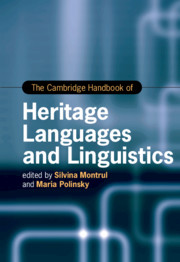Book contents
- The Cambridge Handbook of Heritage Languages and Linguistics
- Cambridge Handbooks In Language And Linguistics
- The Cambridge Handbook of Heritage Languages and Linguistics
- Copyright page
- Dedication
- Contents
- Figures and Tables
- Contributors
- Acknowledgments
- Introduction
- Part I Heritage Languages around the World
- Part II Research Approaches to Heritage Languages
- Part III Grammatical Aspects of Heritage Languages
- 23 Phonetics and Phonology of Heritage Languages
- 24 Morphology of Heritage Languages
- 25 Syntax of Heritage Languages
- 26 Semantics of Heritage Languages
- 27 Discourse and Information Structure in Heritage Languages
- 28 Pragmatics in Heritage Languages
- Part IV Heritage Language Education
- Index
- References
23 - Phonetics and Phonology of Heritage Languages
from Part III - Grammatical Aspects of Heritage Languages
Published online by Cambridge University Press: 04 November 2021
- The Cambridge Handbook of Heritage Languages and Linguistics
- Cambridge Handbooks In Language And Linguistics
- The Cambridge Handbook of Heritage Languages and Linguistics
- Copyright page
- Dedication
- Contents
- Figures and Tables
- Contributors
- Acknowledgments
- Introduction
- Part I Heritage Languages around the World
- Part II Research Approaches to Heritage Languages
- Part III Grammatical Aspects of Heritage Languages
- 23 Phonetics and Phonology of Heritage Languages
- 24 Morphology of Heritage Languages
- 25 Syntax of Heritage Languages
- 26 Semantics of Heritage Languages
- 27 Discourse and Information Structure in Heritage Languages
- 28 Pragmatics in Heritage Languages
- Part IV Heritage Language Education
- Index
- References
Summary
This chapter provides an overview of research on heritage language (HL) sound systems, with a focus on areas of convergence and divergence among heritage speakers (HSs), native speakers (NSs) who continue to be dominant in the language, and second language learners (L2ers) who acquired the language later in life. Drawing on data from a wide range of HLs, the chapter addresses both phonetic (articulatory, acoustic, perceptual) and phonological (phonemic, distributional, phonotactic) aspects of the HL sound system, as well as that of the majority language, in light of theories of bilingual speech and variables previously studied as predictors of HSs’ linguistic behavior. Despite the diversity of results reviewed, several recurring themes emerge, including intermediate patterning between NSs and L2ers, a higher level of performance in perception than production, and individual variability. In particular, the depth and the accessibility of HSs’ knowledge of the HL sound system show considerable variation related to structural linguistic factors, demographic and sociolinguistic factors, input and usage-based factors, and methodological factors. In addition to summarizing the areas in which there is an emerging consensus, the chapter points out a number of remaining questions that pave the way for future research on HL sound systems.
Keywords
- Type
- Chapter
- Information
- The Cambridge Handbook of Heritage Languages and Linguistics , pp. 581 - 612Publisher: Cambridge University PressPrint publication year: 2021
References
- 13
- Cited by



